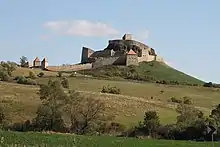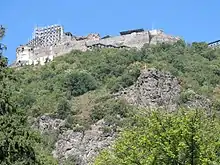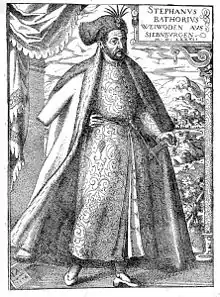فويفود ترانسيلفانيا
ڤويڤود ترانسيلڤانيا (بالمجرية: erdélyi vajda) [1] (بالألمانية: Vojwode von Siebenbürgen) [2] (باللاتينية: voivoda Transsylvaniae) (بالرومانية: voievodul Transilvaniei)، هو لقب منصب [3] المسئول الأعلى رتبة في ترانسيلڤانيا داخل مملكة المجر في الفترة من القرن الثاني عشر إلى القرن السادس عشر الميلادي. كان ملوك المجر يُعيِّنون الڤويڤود رؤساء على «الإيسپان» (بالمجرية: Ispán) الذين هم رؤساء المقاطعات الأخرى في الإقليم. كانت المقاطعات المجرية تُسمى: «المقاطعات البيضاء» (بالمجرية: Fehér vármegye)، وكان الڤويڤود هم أنفسهم أيضا من رؤساء المقاطعات «الإيسپان».
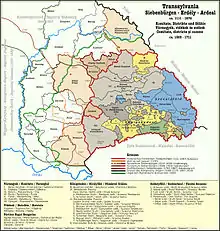

كان لدى الڤويڤود صلاحيات إدارية وعسكرية وقضائية واسعة النطاق، لكن اختصاصاتهم لم تشمل المقاطعة بأكملها، فقد نظمت الجاليات السكسونية والسكيلية (بالمجرية: Székelyek) (السكيلية: مجموعة فرعية من الشعب المجري الذين يعيشون في الغالب في "أرض سيكيلي" في رومانيا) نظمت مناطقهم الخاصة بدئاً من القرن 13، مستقلين بذلك عن الڤويڤود. كما أعفى الملوك بعض مدن وقرى ترانسيلڤانيا من سلطة الڤويڤود على مر القرون. ورغم ذلك، كانت لڤويڤود ترانسيلڤانيا «أكبر كيان إداري منفرد» [4] في المملكة المجرية بأكملها في القرن الخامس عشر. تمتع الڤويڤوديون بدخل كبير من العقارات الملكية المُلحقة بوظيفتهم، ولكن الحق في «منح الأراضي وجمع الضرائب والرسوم أو النقود المعدنية» [5] كان مخصصًا للملوك فقط. على الرغم من تمرد بعض الڤويڤود مثل «رولاند بورسا» (بالمجرية: Roland Borsa)، و«لاديسلاوس كان» (بالمجرية: Kán (III) László) وبعض الڤويڤود الآخرين ضد السيادة، إلا أن معظمهم ظلوا مسؤولين موالين مخلصين.
الاسم
كان اسم إقليم ترانسيلڤانيا تحت الحُكم العثماني: إمارة الأردل.
أصل المنصب
بداية ظهور منصب «الڤويڤود» غير واضحة، [1] ولكن لقب «ڤويڤود» هو من أصل سلاڤي ومعناه «قائد، أو: رتبة مُلازم أول».[6] ورغم أن الإمبراطور قسطنطين السابع بورفيروينيتوس كتب عن شيوخ القبائل المجرية مستخدماً مصطلح «ڤويڤود» [7] حوالي عام 950م، إلا أنه يبدو أنه اعتمد المصطلح الذي استخدمه أحد المترجمين السلاڤ. [8]
أدى موقع ترانسيلڤانيا الحدودي [9] إلى تشكيل نظام «الڤويڤودية»، حيث لم يتمكن الملوك من الحفاظ على السيطرة المباشرة على هذه المنطقة النائية.[10] وهكذا، لم تكن الڤويڤودية مستقلة أبدًا، لكنهم ظلوا مسؤولين محليين يتبعون الملوك. [8] أصبح الڤويڤود رؤساء «المقاطعات البيضاء» (بالمجرية: Fehér vármegye) بدئاً من عام 1201م، [9] مما قد يُشير إلى أن دورهم الأصلي كان «رؤساء مقاطعات» (بالمجرية: ispán) ثم تم ترقيتهم.[11]
المهام
الاختصاص القضائي
تُعرف الأراضي الخاضعة لاختصاص الڤويڤود بأنها «ڤويڤودية ترانسيلڤانيا» [4] (بالمجرية: erdélyi vajdaság)، [13] (بالرومانية: Voievodatul Transilvaniei).[14] وكان الڤويڤود رؤساء على «إيسپان» (رؤساء) المقاطعات الترانسيلڤانية. [11]
علو شرف الڤويڤود
كان منصب الڤويڤود أحد أهم معالم الشرف المَلَكِي في المملكة المجرية، [15] وكان دخل الأراضي الملحقة بالقلاع الملكية في ترانسيلڤانيا يُجمع من أجل الڤويڤود الذين تمتعوا أيضاً بتحصيل دُخول الغرامات، إلا أن العائدات الملكية من الضرائب والرسوم والمناجم ظلت من مستحقات الملوك فقط.[16]
وظائف قضائية
كان الڤويڤود واحد من أعلى القضاة في المملكة المجرية.[17] وبهذه الصفة، أُذن له بإصدار مواثيق «مُصَدَّقة». يرجع تاريخ أول وثيقة محفوظة إلى عام 1248م.[18]
وظائف عسكرية
يشير أصل كلمة «ڤويڤود» ومعناها: «القائد» إلى أن الڤويڤود كان له واجبات عسكرية كبيرة.[20] لقد كان الڤويڤود هو القائد الأعلى للقوات التي يتم تجنيدها في المقاطعات الخاضعة لولايتها القضائية. وعلى الرغم من أن القانون كان يُلزم النبلاء بالقتال في جيش الملك، إلا أن نبلاء ترانسيلڤانيا قاتلوا أيضاً تحت قيادة الڤويڤود.[21] علاوة على ذلك، كان للڤويڤود حاشية خاصة بهم تتشكل في المقام الأول من النبلاء المسلحين. وأيضاً تم تأكيد حق الڤويڤود في تكوين جيش تحت علمهم بموجب تشريع صدر عام 1498م.[22]
التعاون والصراعات
اندلع تمرد ضد السلطة الملكية في ترانسيلڤانيا عام 1467م [23] بسبب ضريبة جديدة فرضها الملك ماتياس كورفينوس. قام الملك بإخماد التمرد خلال أسبوع ولكنه لم يحكم على الڤويڤود الثلاثة الذين قادوا التمرد، لأن دورهم الفعال في التمرد لم يثبت أبدًا.[24]
نهاية المنصب
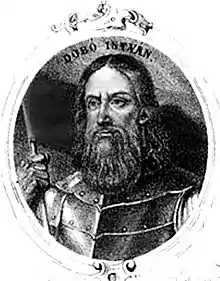
توقف جون سيجسموند عن تسمية نفسه ملكًا للمجر بعد معاهدة «سپاير» (Speyer) لعام 1570م بين المملكتين المجريتين: مملكة المجر بقيادة ماكسيمليان الثاني، والمملكة المجرية الشرقية التي يحكمها جون سيغيسموند زابوليا، والتي بموجبها اعتمد جون سيجسموند لقب «أمير ترانسيلڤانيا وسيد أجزاء من مملكة المجر». [25] [26]
أحيا خليفته ستيفن باتوري، الذي انتُخب حاكمًا من قبل جمعية الأمم الثلاث (النبلاء المجر والسكسون والسكيلي)، لقب ڤويڤود ثانية، فاتخذ اللقب في البداية لنفسه، [25] ثم اتخذ لقب «أمير ترانسيلڤانيا» عندما تم انتخابه ملكاً لبولندا في 1576م، [25] وفي الوقت نفسه منح لقب ڤويڤود لأخيه كريستوفر باتوري في 1576م. [25]
جاء بعد كريستوفر باتوري (Christopher Báthory) في عام 1581م ابنه القاصر سيغيسموند، الذي استمر في وصف نفسه ڤويڤود حتى وفاة عمه ستيفن باتوري (Stephen Báthory) في 1586م. [25] تم الاعتراف بلقب الأمير سيغيسموند باتوري (Sigismund Báthory) في عام 1595م من قبل الإمبراطور رودولف (وكان ملك المجر أيضًا). [25]
قائمة الڤويڤود
القرن الثاني عشر
| زمن الحكم | صاحب المنصب | العاهل | ملاحظات | المصدر |
|---|---|---|---|---|
| ج. 1111 - ج. 1113 | مرقوريوس | كولومان | "princeps Ultrasilvanus" ، ولكنه ربما فقط شخص نبيل متميز | [1] [9] [27] [28] |
| 1176 م. 1196 | Leustach من عشيرة Rátót | بيلا الثالث | أول ڤويڤود يشهد به ميثاق ملكي (من 1230م)؛ أرسل قائداً على التعزيزات المجرية إلى الإمبراطورية البيزنطية ضد السلاجقة في معركة ميريوكيفالون عام 1176م | [6] [29] [30] |
| 1199-1200 | Legforus | إمريك | تم توثيق منصب ڤويڤود الخاص به بواسطة أقدم ميثاق ملكي (من 1199م) | |
| 1200 | Eth من عشيرة Geregye | إمريك | أيضا رئيس (ispán) مقاطعة (Fehér) | [31] |
القرن الثالث عشر
| زمن الحكم | صاحب المنصب | العاهل | ملاحظات | المصدر |
|---|---|---|---|---|
| 1201 | Julius of the Kán clan | Emeric | first rule; also ispán of Fehér County | |
| 1201 | Nicholas (I) | Emeric | according to a non-authentic charter also in 1202 | |
| 1202–1206 | Benedict, son of Korlát | Emeric, Ladislaus III, Andrew II | first rule | |
| 1206 | Smaragd of the Smaragd clan | Andrew II | ||
| 1208–1209 | Benedict, son of Korlát | Andrew II | second rule; conspired against the king who exiled him | |
| 1209–1212 | Michael of the Kacsics clan | Andrew II | first voivode receiving land grant in Transylvania | |
| 1212–1213 | Berthold of Merania | Andrew II | brother of Gertrud, Andrew II's queen; also archbishop of Kalocsa | |
| 1213 | Nicholas (II) | Andrew II | ||
| 1214 | Julius of the Kán clan | Andrew II | second rule; also ispán of Szolnok County (1214) | |
| 1215 | Simon of the Kacsics clan | Andrew II | ||
| 1216–1217 | Ipoch of the Bogátradvány clan | Andrew II | ||
| 1217 | Raphael | Andrew II | he might have been in office in 1218 (Kurt W. Treptow, Marcel Popa) | |
| 1219–1221 | Neuka | Andrew II | ||
| 1221–1222 | Paul, son of Peter | Andrew II | ||
| 1227 | Pousa, son of Sólyom | Andrew II | first rule | |
| 1229–1231 | Julius of the Rátót clan | Andrew II | ||
| 1233–1234 | Denis of the Türje clan | Andrew II | ||
| 1235 | Andrew, son of Serafin | Béla IV | also ispán of Pozsony County (1235) | |
| 1235–1241 | Pousa, son of Sólyom | Béla IV | second rule; died fighting against the invading Mongols | |
| 1242–1252 | Lawrence | Béla IV | also ispán of Valkó County | |
| b. 1261 | Ernye of the Ákos clan | Béla IV | banus quondam Transiluanus in 1261 | |
| 1261 | Csák of the Hahót clan | Béla IV | banus Transilvanus; also ispán of Szolnok County (1261); the king's son, Stephen is duke of Transylvania | |
| 1263–1264 | Ladislaus (II) of the Kán clan | Béla IV | first rule; also ispán of Szolnok County (1263–1264); the king's son, Stephen is duke of Transylvania | |
| 1267–1268 | Nicholas of the Geregye clan | Béla IV | first rule; also ispán of Szolnok County (1267–1268); it is presumable, he held the dignity uninterruptedly from 1264 to 1270; the king's son, Stephen is duke of Transylvania | |
| 1270–1272 | Matthew of the Csák clan | Stephen V | first rule; also ispán of Szolnok County (1270–1272) | |
| 1272–1273 | Nicholas of the Geregye clan | Ladislaus IV | second rule; also ispán of Szolnok County (1272–1273) | |
| 1273 | John | Ladislaus IV | also ispán of Szolnok County (1273) | |
| 1273–1274 | Nicholas of the Geregye clan | Ladislaus IV | third rule; also ispán of Szolnok County (1273–1274) | |
| 1274 | Matthew of the Csák clan | Ladislaus IV | second rule; also ispán of Szolnok County (1274) | |
| 1274 | Nicholas of the Geregye clan | Ladislaus IV | fourth rule; maybe in 1275 (Kurth W. Treptow, Marcel Popa); also ispán of Szolnok County (1274) | |
| 1274–1275 | Matthew of the Csák clan | Ladislaus IV | third rule; also ispán of Szolnok County (1274–1275) | |
| 1275 | Ugrin of the Csák clan | Ladislaus IV | first rule; also ispán of Szolnok County (1275) | |
| 1275–1276 | Ladislaus (II) of the Kán clan | Ladislaus IV | second rule; also ispán of Szolnok County (1275–1276) | |
| 1276 | Ugrin of the Csák clan | Ladislaus IV | second rule; also ispán of Szolnok County (1276) | |
| 1276 | Matthew of the Csák clan | Ladislaus IV | fourth rule; also ispán of Szolnok County (1276) | |
| 1277 | Nicholas of the Pok clan (Meggyesi) | Ladislaus IV | first rule; also ispán of Szolnok County (1277) | |
| 1278–1280 | Finta of the Aba clan | Ladislaus IV | also ispán of Szolnok County (1278–1280); captured the king | |
| 1280 | Stephen, son of Tekesh | Ladislaus IV | also ispán of Szolnok County (1280) | |
| 1282 | Roland of the Borsa clan | Ladislaus IV | first rule; also ispán of Szolnok County (1282) | |
| 1283 | Apor of the Péc clan | Ladislaus IV | also ispán of Szolnok County (1283) | |
| 1284–1294 | Roland of the Borsa clan | Ladislaus IV, Andrew III | second rule; also ispán of Szolnok County (1284–1294); successfully fought against the invading Mongols in 1285; rebelled against both kings | |
| 1287–c. 1288 (?) | Mojs of the Ákos clan | Ladislaus IV | only a non-authentic charter refers to him as voivode, if so, he was also ispán of Szolnok County in the same period | |
| 1295–1314 or 1315 | Ladislaus (III) of the Kán clan | Andrew III | de facto independent ruler; also ispán of Szolnok County (1295–1314) |
القرن الرابع عشر
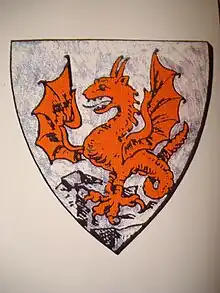
| زمن الحكم | صاحب المنصب | العاهل | ملاحظات | المصدر |
|---|---|---|---|---|
| c. 1315 | Ladislaus (IV) of the Kán clan | self declared voivode, son of Ladislaus (III) Kán (1295–1314) | ||
| 1315–1316 | Nicholas Meggyesi | Charles I | second rule; unable to take up his office; also ispán of Szolnok County (1315–1316) | |
| 1318–1321 | Dózsa Debreceni | Charles I | also ispán of Szolnok County (1318–1321) | |
| 1321–1342 | Thomas Szécsényi | Charles I | also ispán of Szolnok County (1321–1342), ispán of Arad County (1330–1342), and ispán of Csongrád County (1330) | |
| 1342–1344 | Nicholas Sirokai | Louis I | also ispán of Arad and Szolnok Counties (1342–1344) | |
| 1344–1350 | Stephen Lackfi | Louis I | also ispán of Arad and Szolnok Counties (1344–1350) | |
| 1350–1351 | Thomas Gönyűi or Csór | Louis I | appointed by Stephen, duke of Transylvania, the monarch's brother; also ispán of Arad and Szolnok Counties (1350–1351) | |
| 1351–1356 | Nicholas Kont of Orahovica | Louis I | also ispán of Arad and Szolnok Counties (1351–1356) | |
| 1356–1359 | Andrew Lackfi | Louis I | brother of Stephen Lackfi (1344–1350); also ispán of Arad and Szolnok Counties (1356–1359) | |
| 1359–1367 | Denis Lackfi | Louis I | son of Stephen Lackfi (1344–1350); also ispán of Arad and Szolnok Counties (1359–1367) | |
| 1367–1368 | Nicholas Lackfi, Jr. | Louis I | son of Stephen Lackfi (1344–1350); also ispán of Arad and Szolnok Counties (1367–1368) | |
| 1369–1372 | Emeric Lackfi | Louis I | son of Stephen Lackfi (1344–1350); also ispán of Arad and Szolnok Counties (1369–1372) | |
| 1372–1376 | Stephen Lackfi of Csáktornya | Louis I | first rule; son of Stephen Lackfi (1344–1350); also ispán of Szolnok County (1372–1376) | |
| 1376–1385 | Ladislaus Losonci, Sr. | Louis I, Mary | first rule; also ispán of Szolnok County (1376–1385) | |
| 1385–1386 | Stephen Lackfi of Csáktornya | Charles II | second rule; also ispán of Szolnok County (1385–1386) | |
| 1386–1392 | Ladislaus Losonci, Sr. | Sigismund, Mary | second rule; also ispán of Szolnok County (1386–1392) | |
| 1392–1393 | Emeric Bebek | Sigismund, Mary | also ispán of Szolnok County (1392–1393) | |
| 1393–1395 | Frank Szécsényi | Sigismund, Mary | also ispán of Arad, Csongrád, and Szolnok Counties (1393–1395) | |
| 1395–1401 | Stibor of Stiboricz | Sigismund | first rule; also ispán of Arad and Szolnok Counties (1395–1401) |
القرن الخامس عشر

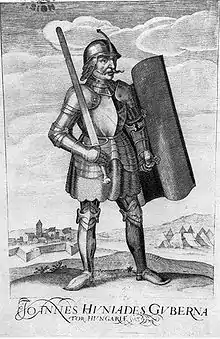
| زمن الحكم | صاحب المنصب | العاهل | ملاحظات | المصدر |
|---|---|---|---|---|
| 1401 | Simon Szécsényi | Sigismund | also ispán of Szolnok County (1401) | |
| 1402–1403 | Nicholas Csáki | Sigismund | first rule; also ispán of Békés, Bihar, Csanád, Csongrád, Keve, Krassó, Szolnok, Temes, and Zaránd Counties (1402–1403); a leader of the party supporting King Ladislaus of Naples's claim to the Hungarian throne in 1403 | |
| Nicholas Marcali | also ispán of Békés, Csanád, Csongrád, Keve, Krassó, Szolnok, Temes, and Zaránd Counties (1402–1403); joined the party supporting King Ladislaus of Naples's claim to the Hungarian throne in 1403 | |||
| 1403–1409 | John Tamási | Sigismund | also ispáns of Szolnok County (1403–1409) | |
| James Lack of Szántó | ||||
| 1409–1414 | Stibor of Stiboricz | Sigismund | second rule; also ispán of Szolnok County (1409–1414), Nyitra and Trencsén, Lord of all Váh | |
| 1415–1426 | Nicholas Csáki | Sigismund | second rule; also ispán of Békés, Bihar, and Szolnok Counties (1415–1426) | |
| 1426–1437 | Ladislaus Csáki | Sigismund | second rule; together with Peter Cseh of Léva (1436–1437); also ispán of Közép-Szolnok County (1426–1437), ispán of Szatmár County (1430–1437), and ispán of Bihar County (1433–1437); routed by the rebelling peasants at Dés (Dej); | |
| 1436–1438 | Peter Cseh of Léva | Sigismund, Albert | together with Ladislaus Csáki (1426–1437) | |
| 1438–1441 | Desiderius Losonci | Albert, Ladislaus V | left Ladislaus V's party and became Wladislas I's partisan in 1441 | |
| 1440–1441 | Ladislaus Jakcs | Wladislas I | ||
| Michael Jakcs | ||||
| 1441–1458 | Nicholas Újlaki | Wladislas I, Ladislaus V | first rule; together with John Hunyadi (1441–1446), with Emeric Bebek (1446–1448), and with John Rozgonyi (1449–1458); also ban of Macsó and commander of Nándorfehérvár (Beograd, Serbia) (1441–1458), count of the Székelys (1441–1446), ispán of Csanád, Csongrád, Máramaros, and Temes Counties (1441–1446), ispán of Arad County (1444–1446), ban of Severin (1445–1446), and ban of Slavonia (1457) | |
| 1441–1446 | John Hunyadi | Wladislas I | together with Nicholas Újlaki (1441–1458); also commander of Nándorfehérvár (Beograd, Serbia) (1441–1446), count of the Székelys (1441–1446), ispán of Csanád, Csongrád, and Temes Counties (1441–1446), ispán of Arad and Bihar Counties (1443–1446), ispán of Közép-Szolnok, Kraszna, Szabolcs, Szatmár, and Ugocsa Counties (1444–1446), ispán of Bereg and Máramaros Counties (1445–1446), and regent-governor of the Kingdom of Hungary (1446) | |
| 1446–1448 | Emeric Bebek | elected by the Diet of Hungary | together with Nicholas Újlaki (1441–1458); also ispán of Abaúj County (1446–1448) and judge of the Jász people (1446–1448); died fighting against the Ottomans in the second battle of Kosovo | |
| 1449–1458 | John Rozgonyi | first rule; together with Nicholas Újlaki (1441–1458); also ispán of Sopron and Vas Counties (1449–1454), count of the Székelys (1457–1458) | ||
| 1459–1461 | Ladislaus Kanizsai | Matthias | together with John and Sebastian Rozgonyi (1459–1460), and with his brother, Nicholas Kanizsai (1461) | |
| 1459–1460 | John Rozgonyi | Matthias | together with Ladislaus Kanizsai (1459–1461), and with Sebastian Rozgonyi (1459–1460) | |
| 1459–1460 | Sebastian Rozgonyi | Matthias | together with Ladislaus Kanizsai (1459–1461), and with John Rozgonyi (1459–1460) | |
| 1461 | Nicholas Kanizsai | Matthias | together with his brother, Ladislaus Kanizsai (1459–1461) | |
| 1462–1465 | Nicholas Újlaki | Matthias | second rule | |
| John Pongrác of Dengeleg | Matthias | first rule | ||
| 1465–1467 | Bertold Ellerbach of Monyorókerék | Matthias | dismissed after rebellious Transylvanian nobles elected them to their leaders | |
| Count Sigismund Szentgyörgyi | brothers of Count Peter Szentgyörgyi (1498–1510); dismissed after rebellious Transylvanian nobles elected them to their leaders | |||
| Count John Szentgyörgyi | ||||
| 1468–1474 | Nicholas Csupor of Monoszló | Matthias | together with John Pongrác of Dengeleg (1468–1472) | |
| 1468–1472 | John Pongrác of Dengeleg | Matthias | second rule; together with Nicholas Csupor of Monoszló (1468–1474) | |
| 1472–1475 | Blaise Magyar | Matthias | leader of Hungarian reinforcements sent to Stephen the Great, prince of Moldavia in the Battle of Vaslui of 1475 | |
| 1475–1476 | John Pongrác of Dengeleg | Matthias | third rule | |
| 1478–1479 | Peter Geréb of Vingárt | Matthias | ||
| 1479–1493 | Stephen (V) Báthory of Ecsed | Matthias, Wladislas II | ||
| 1493–1498 | Bartholomew Drágfi of Béltek | Wladislas II | together with Ladislaus Losonci, Jr. (1493–1494); suppressed a rebellion of the Székelys | |
| 1493–1495 | Ladislaus Losonci, Jr. | Wladislas II | together with Bartholomew Drágfi of Béltek (1493–1498) | |
| 1498–1510 | Count Peter Szentgyörgyi | Wladislas II | brother of Counts Sigismund and John Szentgyörgyi (1465–1467) |
القرن السادس عشر
| زمن الحكم | صاحب المنصب | العاهل | ملاحظات | المصدر |
|---|---|---|---|---|
| 1510-1526 | جون زابوليا (زابولاي) | فلاديلاس الثاني، لويس الثاني | أصبح ملك المجر | [2] [32] [33] |
| 1527-1529 | بيتر بيريني | جون زابوليا | غادر حزب جون زابوليا وأصبح حزبيًا من فرديناند الأول | [34] |
| 1530-1534 | ستيفن (الثامن) باتوري سومليو | فرديناند الأول | ||
| 1530 | بالينت توروك | |||
| 1530-1534 | جيروم لاسكي | جون زابوليا | تآمر ضد الملك الذي سجنه | [35] |
| 1533-1534 | اميرك شيباك | |||
| 1534-1540 | ستيفن Majláth من Szunyogszeg | جون زابوليا | مع Emeric Balassa من Gyarmat (1538-1540)؛ خططت لعزل ترانسيلڤانيا من مملكة المجر، ولكن تم الاستيلاء عليها من قبل العثمانيين | [25] [36] |
| 1538-1540 | إمريك بالاسا من غيارات | جون زابوليا | جنبا إلى جنب مع ستيفن Majláth من Szunyogszeg (1534-1540)؛ فر عندما غزا العثمانيون ترانسيلڤانيا | [25] |
| 1551 | جورج مارتينوزي | فرديناند الأول | أيضًا حاكم ترانسيلڤانيا نيابة عن القاصر جون سيغيسموند، الملك المنتخب (1543-1551) | [25] |
| 1552-1553 | أندرو بوثوري من إيكسيد | فرديناند الأول | استقال | [37] |
| 1553-1556 | ستيفن دوبو | فرديناند الأول | آخر ڤويڤود مُعين من قبل ملك المجر | |
| فرانسيس كيندي | ||||
| 1571-1576 | ستيفن باتوري | انتخبت من قبل الأمم الثلاث وأكده السلطان العثماني سليم الثاني؛ أعلن نفسه أمير ترانسيلڤانيا بعد انتخابه ملكًا لبولندا عام م1576 | [25] | |
| 1576-1581 | كريستوفر باتوري | ستيفن باتوري | [25] | |
| 1581-1586 | سيجيسوند باتوري | ستيفن باتوري | ڤويڤود الماضي؛ أكد لقب أمير أمير ترانسيلڤانيا عام 1595 من قبل الإمبراطور رودولف | [25] [38] |
انظر أيضا
المراجع
- Zsoldos 2011, p. 36.
- Fallenbüchl 1988, p. 77.
- Negrău 2011, p. 92.
- Jefferson 2012, p. 142.
- Sedlar 1994, p. 275.
- Kristó 2003, p. 97.
- Constantine Porphyrogenitus: De Administrando Imperio (ch. 38.), p. 171.
- Bóna 1994.
- Curta 2006.
- Rady 2000, p. 18.
- Kristó 2003, p. 98.
- Engel 1996, p. 348.
- Kristó 1979, p. 110
- Pop 1996, p. 143
- Engel 2001, p. 151.
- Makkai 1994, p. 200.
- Rady 2000, p. 69.
- Kristó 2003, p. 222.
- Engel 1996, p. 299.
- Pop 2005, p. 246.
- Mályus 1994, p. 29.
- Rady 2000, pp. 147, 152–153
- Makkai 1994, p. 228.
- Engel 2001, p. 302.
- Barta 1994.
- Felezeu 2009, p. 25.
- Engel 2001, pp. 35., 381.
- Treptow, Popa 1996, p. lvi.
- Engel 2001, p. 381.
- Markó 2000, p. 291.
- Zsoldos 2011, p. 37.
- Treptow, Popa 1996, p. lviii.
- Engel 2001, p. 384.
- Markó 2000, pp. 290–291.
- Markó 2000, pp. 287–288.
- Markó 2000, p. 282.
- Markó 2000, p. 256.
- Szegedi 2009, p. 101.
- بوابة المجر
